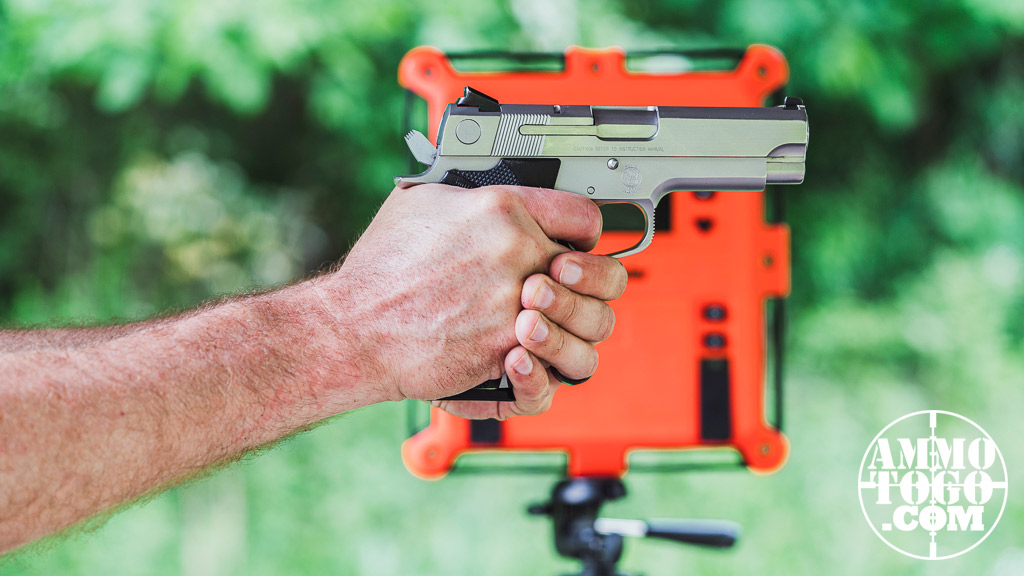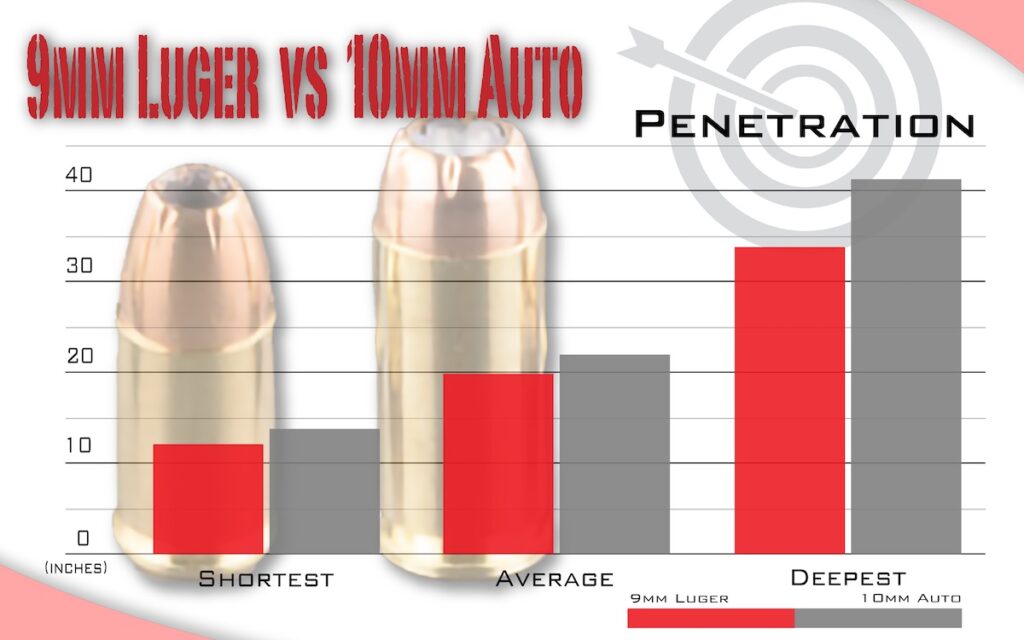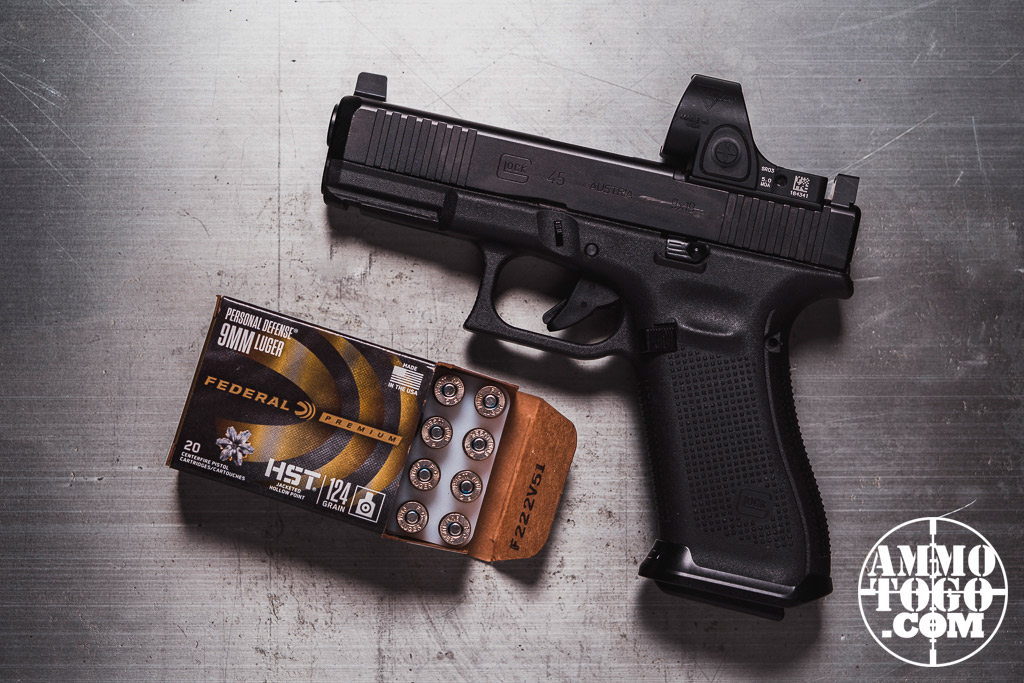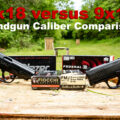What can a single millimeter do? That, after all, is the difference between the 9mm Luger and the 10mm Auto. With such close sizes, there must be a minimal difference between these two popular handgun rounds. But one millimeter is simply the difference in bullet diameter. It doesn’t come close to telling the entire story. […]
What can a single millimeter do?
That, after all, is the difference between the 9mm Luger and the 10mm Auto. With such close sizes, there must be a minimal difference between these two popular handgun rounds.
But one millimeter is simply the difference in bullet diameter. It doesn’t come close to telling the entire story. It doesn’t describe overall length, case capacity, or bullet weights. It certainly doesn’t tell us the difference in handgun options, magazine capacity, availability, and pricing.
9mm vs. 10mm
Both 9mm and 10mm are common calibers of American shooters looking for a self-defense round. That said, 9mm is smaller and generally produces less muzzle energy than 10mm. As a result, for shooters concerned with bullet expansion and penetration, 10mm is generally considered a better choice. With that in mind, 9mm does typically offer a shooter more magazine capacity and recoil that most shooters would consider more manageable than 10mm.
With that summary in mind, let’s take a deep dive into the physical dimensions, the ammo market, and ballistic performance of both 9mm and 10mm to truly understand the difference as you make your pick.
9mm vs 10mm: Specs
| 9x19mm | 10mm Auto | |
|---|---|---|
| Released | 1901 | 1983 |
| Bullet diameter | 0.355 inches | 0.4005 inches |
| Neck diameter | 0.38 inches | 0.423 inches |
| Base diameter | 0.391 inches | 0.425 inches |
| Rim diameter | 0.392 inches | 0.425 inches |
| Case length | 0.754 inches | 0.992 inches |
| Case capacity | 0.826 cubic centimeters | 1.56 cubic centimeters |
| Total length | 1.169 inches | 1.260 inches |
| Typical bullet weights | 70- 150 grains | 130 - 200 grains |
| Common firearm | Semiautomatic pistols | Semiautomatic pistols |
| Common magazine capacity | Up to 20 | 10 to 15 |
Size and Shape
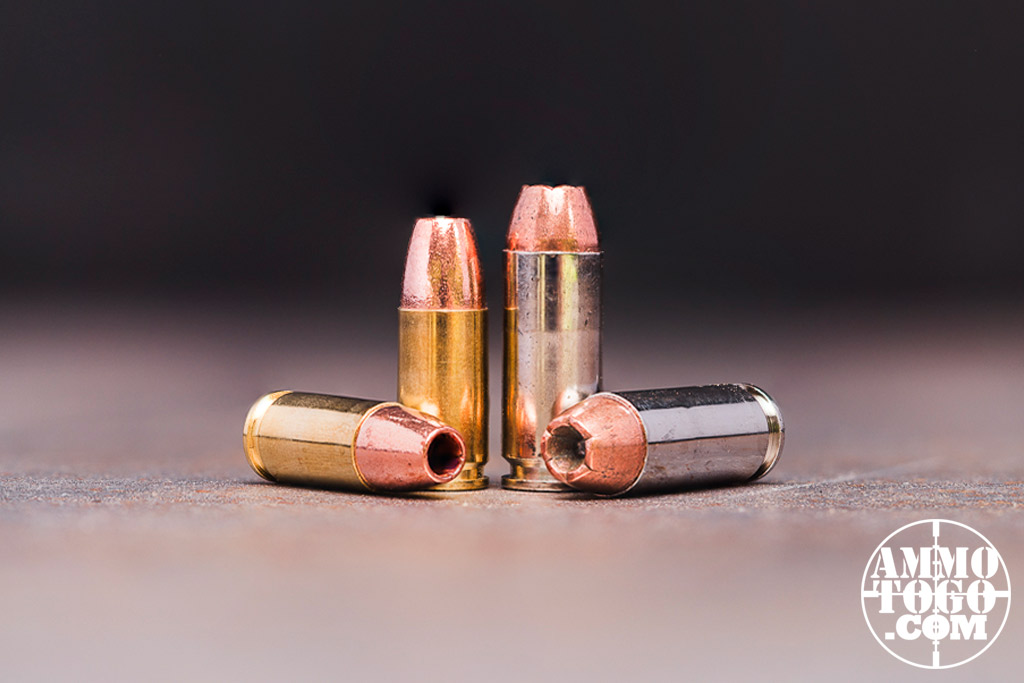
While the “9mm” vs “10mm” suggests a minimal difference, the physical dimensions of these cartridges are very different. Simply put, the 10mm makes the 9mm look small. The case difference is especially noticeable; the 10mm’s case capacity is noticeably larger and almost doubles the 9mm’s.
The 10mm also seats heavier bullets. Most 9mm Luger rounds range from 115 to 147 grains, while the 10mm commonly starts at 180 and goes up to 200. There are outliers for both, such as 70-grain 10mm products, but the vast majority are within these ranges.
Availability and Pricing Differences
The 9mm Luger is the most used handgun cartridge in America. The 10mm Auto is popular, but it doesn’t come in as many options and doesn’t have the same budget-friendly pricing. Users of the 10mm can find ammo but 9mm users are nearly guaranteed to find ammunition options of all types.
Firearm Type and Firearm Capacity
Both of these rounds are fired from semiautomatic weapons. The difference, however, is in the capacity. Whether you keep a handgun for plinking, competition, or self-defense, magazine capacity matters. (And it especially matters for self-defense.)
Most 9mm handguns carry about 17 to 20 rounds in the magazine, while 10mm pistols pack 10 to 15. If you want a compact handgun for concealed carry, you’ll get more shots per magazine from a 9mm handgun.
9mm Luger vs 10mm Ballistics
To create our velocity and energy analysis, we took four samples from each cartridge. For consistency, we used the same four manufacturers in each group. We then looked at muzzle, 25-yard, and 50-yard stats and calculated the averages. It’s a small sample, but it helps us understand the potential for these two handgun rounds.
Velocity Comparison
| 9mm Luger | Muzzle (fps) | 25 yards | 50 yards |
|---|---|---|---|
| 115-grain VOR-TX (Barnes) | 1,125 | 1,079 | 1,040 |
| 124-grain Golden Saber Defense (Remington) | 1,125 | 1,074 | 1,031 |
| 135-grain Personal Defense Hydra-Shok (Federal) | 1,060 | 1026 | 996 |
| 147-grain Gold Dot (Speer) | 985 | 957 | 932 |
| Average | 1,074 | 1,034 | 1,000 |
The 9mm Luger has lighter bullets, which often means a faster velocity. However, the 10mm Auto has a larger case, so there is more propellant behind the projectile. While there is significant overlap in speeds, the 10mm Luger appears to have an edge.
| 10mm Auto | Muzzle (fps) | 25 yards | 50 yards |
|---|---|---|---|
| 155-grain VOR-TX (Barnes) | 1,150 | 1,105 | 1,067 |
| 180-grain Golden Saber Bonded (Remington) | 1,150 | 1,102 | 1,062 |
| 180-grain Versatile Hollow Point (Federal) | 1,175 | 1,122 | 1,077 |
| 200-grain Gold Dot Handgun Personal Protection (Speer) | 1,100 | 1,054 | 1,015 |
| Average | 1,144 | 1,096 | 1,055 |
Our brief analysis shows a slight advantage for the 10mm Auto. It’s not a major difference, but you’ll find that most 10mm Autos are just a bit faster.
Energy
| 9mm Luger | Muzzle (ft-lbs) | 25 yards | 50 yards |
|---|---|---|---|
| 115-grain TAC-TX (Barnes) | 323 | 297 | 276 |
| 124-grain Golden Saber Defense (Remington) | 348 | 317 | 293 |
| 135-grain Personal Defense Hydra-Shok (Federal) | 337 | 316 | 298 |
| 147-grain Gold Dot (Speer) | 317 | 299 | 284 |
| Average | 331 | 307 | 288 |
| 10mm Auto | Muzzle (ft-lbs) | 25 yards | 50 yards |
| 155-grain VOR-TX (Barnes) | 455 | 421 | 392 |
| 180-grain Golden Saber Bonded (Remington) | 529 | 486 | 451 |
| 180-grain Versatile Hollow Point (Federal) | 552 | 503 | 463 |
| 200-grain Gold Dot Handgun Personal Protection (Speer) | 537 | 493 | 457 |
| Average | 518 | 476 | 441 |
Heavier projectiles, faster speeds. You don’t have to look at the stats to know that the 10mm Auto will be more powerful. The difference in this case is significant, as the 10mm Auto has numerous products with muzzle energies over 500 ft-lbs. None of the 9mm rounds reached 400.
For a self-defense handgun, energy to the target is what really matters, so if we’re simply looking at per-shot energy (far from the only factor), the 10mm Luger holds an advantage.
Penetration
For the next two sections, we consulted data from Ammo To Go, which keeps information on penetration and expansion for a variety of self-defense and protection loads. For an expansive analysis, we looked at the minimum, maximum, and average for each ballistic category.
| Penetration | Shortest (inches) | Average | Deepest |
|---|---|---|---|
| 9mm Luger | 11.68 | 19.5 | 33.4 |
| 10mm Auto | 13.38 | 21.23 | 40.9 |
| Expansion | Thinnest (inches) | Average | Widest |
| 9mm Luger | 0.37 | 0.48 | 0.7 |
| 10mm Auto | 0.4 | 0.62 | 0.79 |
The more powerful 10mm Auto penetrates deeper, which, considering the wider projectile, was not guaranteed. Deeper is not always better, but this shows how the 10mm Luger can be a significantly more powerful self-defense option.
When it comes to stopping a threat (or harvesting a game animal), the wider the wound channel, the better. Unsurprisingly, the 10mm Auto, which starts wider, also expands into a larger mushroom. This is another indication that shot-to-shot, the 10mm Auto has superior self-defense ballistics.
Recoil
The 9mm is significantly better for light recoil, a major factor for the 9mm’s popularity. It’s more manageable for lightweight or beginner shooters, and the chance for rapid, accurate followup shots is better as well.
Making the Choice: 9mm Luger or 10mm Auto
Advantages of the 9mm Luger
- A better ammo market with more options and cheaper cartridges.
- Less recoil makes it a favorite among the shooting community.
- A higher capacity in compact handguns makes the 9mm a self-defense staple.
Advantages of the 10mm Auto
- More velocity with a heavier bullet translates into significantly more power.
- Shot-for-shot, the 10mm Auto has far more stopping power with wider wound channels.
- Higher energies and penetration make it a better choice for hunting.
The 9mm is, for good reason, the most popular handgun cartridge in America. It’s not “better” than the 10mm Auto, but the manageable recoil and higher capacity make it ideal for concealed carry. Also, the low-cost rounds mean better longterm affordability, especially for high-volume shooters.
However, countless Americans use the 10mm every day. It’s a fine choice for concealed carry, and the added per-shot stopping power can be beneficial for personal protection and even hunting.
Get Superior Service on Affordable Ammo!
Find the rounds you need by our 9mm ammo and 10mm ammo pages today. You’ll get reliable support from a group that truly understands the needs of shooters and hunters just like you!



